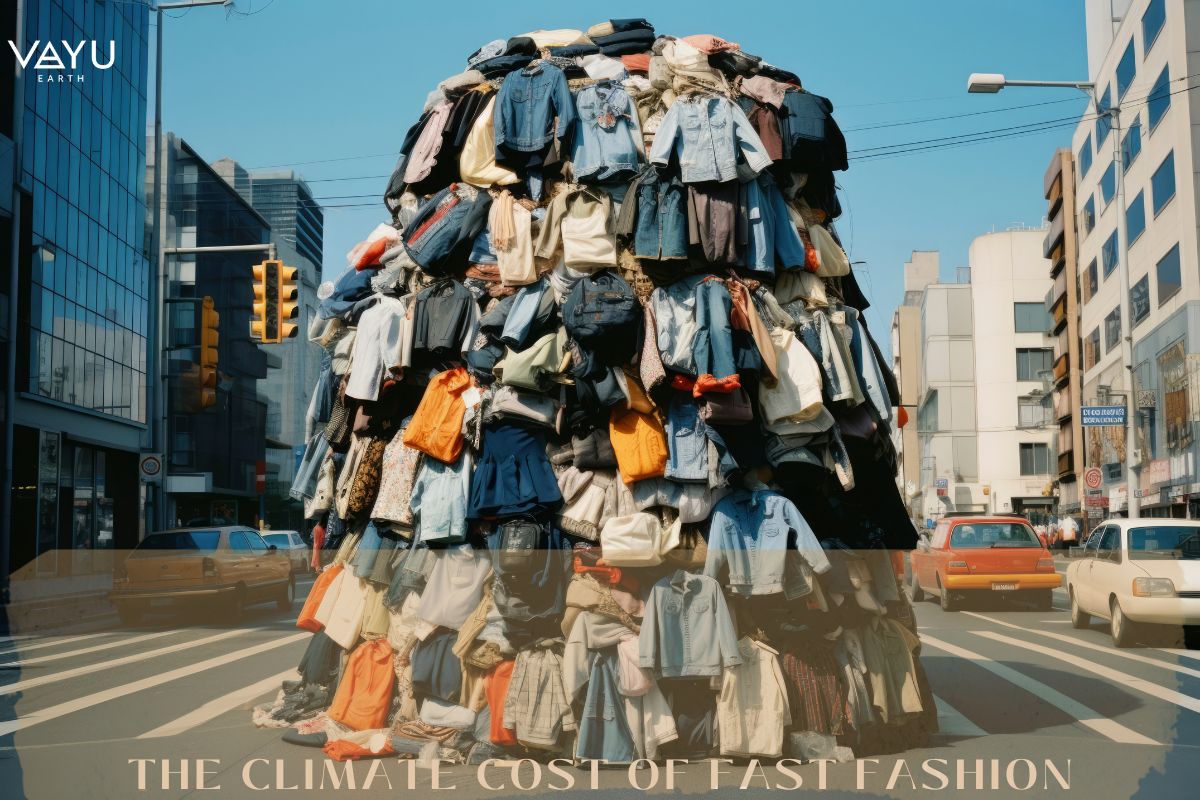The Climate Cost of Fast Fashion: A Global Crisis and Pathways to Change

The fashion industry, once a symbol of creativity and self-expression, has morphed into one of the planet’s most polluting sectors. In 2025, fast fashion remains a key driver of environmental degradation, contributing 10% of global carbon emissions—surpassing the combined emissions of international flights and maritime shipping. As consumers, policymakers, and brands grapple with this crisis, understanding its scale and aligning with global sustainability frameworks like the UN Sustainable Development Goals (SDGs) becomes critical. This blog explores fast fashion’s climate impact, its clash with the SDGs, and how sustainable brands like Vayu Earth are pioneering ethical alternatives.
Fast Fashion’s Environmental Footprint

The term “fast fashion” refers to cheap, rapidly produced clothing that mimics catwalk trends. While affordable, its environmental costs are staggering:
1. Carbon Emissions
-
Producing a single polyester blouse emits 11.6 kg of CO₂, while the industry collectively generates 1.2 billion tonnes of CO₂ annually.
-
Synthetic fabrics like polyester, derived from fossil fuels, release 706 billion kg of CO₂ yearly and take 200 years to decompose.
2. Water Exploitation

-
Manufacturing one pair of jeans consumes 7,000 litres of water, and textile dyeing contributes to 20% of global water pollution.
-
Microplastics from synthetic fabrics add 500,000 tonnes of plastic waste to oceans annually, threatening marine ecosystems.
3. Waste Crisis

-
Fast fashion generates 92 million tonnes of textile waste yearly, with 87% of materials ending up in landfills or incinerators.
-
Garments are worn just 7 times on average before disposal, fuelling a cycle of overconsumption.
Fast Fashion vs. the Sustainable Development Goals

The UN’s 17 Sustainable Development Goals (SDGs) provide a blueprint for combating poverty, inequality, and climate change by 2030. Fast fashion directly undermines several SDGs:
-
SDG 6 (Clean Water): Toxic dyes and water-intensive processes pollute freshwater sources.
-
SDG 12 (Responsible Consumption): The industry’s “52 micro-seasons a year” model promotes wasteful overproduction.
-
SDG 13 (Climate Action): Fossil fuel-dependent supply chains exacerbate global heating.
-
SDG 14 (Life Below Water): Microplastics and chemical runoff harm marine biodiversity.
-
SDG 8 (Decent Work): Exploitative labour practices, including child labour, persist in garment factories.
To achieve the SDGs, the fashion sector must transition to circular models, ethical labour practices, and low-carbon materials.
Sustainable Alternatives: Brands Leading the Change
Consumers increasingly seek brands that align with the SDGs. Here are pioneers redefining the industry:
Vayu Earth: Ethical Home Decor with Purpose

UK-based Vayu Earth exemplifies how sustainability can be woven into every thread of production. Their mission focuses on:
-
Ethical Supply Chains: Partnering with artisans who adhere to the Ethical Trading Initiative (ETI), ensuring fair wages and safe workplaces.
-
Eco-Friendly Materials: Using organic cotton, linen, and recycled fabrics to minimise water and carbon footprints.
-
Zero Exploitation: Prohibiting child labour and discrimination while promoting gender equality in their workforce.
-
Circular Practices: Designing timeless home décor to reduce waste, aligning with SDG 12.
Vayu Earth’s rugs, textiles, and décor items prove that style and sustainability can coexist, offering consumers a way to beautify their homes without harming the planet.
Other Sustainable Brands to Support

-
The Citizenry: Fair Trade-certified homeware using GOTS organic cotton and FSC-certified wood.
-
Ten Thousand Villages: Affordable, artisan-made décor supporting global craft communities.
-
Veo: A curated platform for vetted sustainable brands, from furniture to kitchenware.
How Consumers Can Drive Change

-
Buy Less, Choose Well: Opt for durable, timeless pieces over trendy items.
-
Support Ethical Brands: Prioritise certifications like Fair Trade, GOTS, or B Corp.
-
Repurpose and Recycle: Donate, swap, or upcycle clothing and homeware.
-
Advocate for Policy Change: Demand stricter regulations on fast fashion’s environmental and labour practices.
Conclusion
Fast fashion’s environmental toll is a stark reminder of the urgent need for systemic change. By aligning with the SDGs and supporting brands like Vayu Earth, consumers can help build a future where fashion and home decor celebrate craftsmanship, equity, and planetary health. As the UN warns, the industry’s emissions could rise 50% by 2030 without intervention—making conscious choices today isn’t just stylish, but essential.
Explore Vayu Earth’s sustainable collections: https://vayuearth.com/





